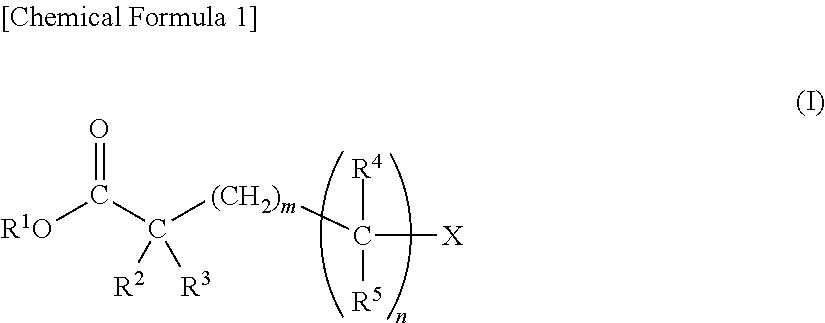Nonaqueous electrolyte solution and electrochemical element using same
a technology of electrolyte solution and electrochemical element, which is applied in the direction of group 5/15 element organic compounds, non-aqueous electrolyte cells, electrochemical generators, etc., can solve the problems of affecting and the battery performance such as battery capacity and cycle properties may be greatly worsened, so as to improve the low-temperature load characteristics, improve the high-temperature cycle properties and low-temperature properties, and improve the low-temperature cycle load characteristics
- Summary
- Abstract
- Description
- Claims
- Application Information
AI Technical Summary
Benefits of technology
Problems solved by technology
Method used
Image
Examples
examples
[0346]Synthesis Examples of novel compounds of the present invention, and Examples of electrolytic solution using the compound and others are shown below. However, the present invention is not limited to these Examples.
examples i-1 to i-15
, Comparative Examples I-1 to I-2
(1) Production of Lithium Ion Secondary Battery
[0347]94% by mass of LiCoO2 (positive electrode active material) and 3% by mass of acetylene black (electroconductive agent) were mixed, and added to and mixed in a solution previously prepared by dissolving 3% by mass of polyvinylidene fluoride (binder) in 1-methyl-2-pyrrolidone, thereby preparing a positive electrode mixture paste. The positive electrode mixture paste was applied on one surface of an aluminium foil (collector), then dried, processed under pressure and blanked into a predetermined size, thereby producing a positive electrode sheet. The density of the part of the positive electrode except the collector was 3.6 g / cm3. On the other hand, 95% by mass of artificial graphite (d002=0.335 nm, negative electrode active material) coated with low-crystalline carbon was added to and mixed in a solution previously prepared by dissolving 5% by mass of polyvinylidene fluoride (binder) in 1-methyl-2-py...
example i-16
, Comparative Example I-3
[0351]A negative electrode sheet was produced, using silicon (negative electrode active material) in place of the negative electrode active material used in Example I-5 and Comparative Example I-1. Precisely, 80% by mass of silicon and 15% by mass of acetylene black (electroconductive agent) were mixed, and added to and mixed in a solution previously prepared by dissolving 5% by mass of polyvinylidene fluoride (binder) in 1-methyl-2-pyrrolidone, thereby preparing a negative electrode mixture paste. The negative electrode mixture paste was applied onto a copper foil (collector), dried, processed under pressure, and blanked into a predetermined size, thereby producing a negative electrode sheet. Coin batteries were produced and evaluated in the same manner as in Example I-5 and Comparative Example I-1, except that the negative electrode sheet produced herein was used. The results are shown in Table 2.
TABLE 2Composition of ElectrolyteAmount AddedSalt(content in...
PUM
 Login to View More
Login to View More Abstract
Description
Claims
Application Information
 Login to View More
Login to View More - R&D
- Intellectual Property
- Life Sciences
- Materials
- Tech Scout
- Unparalleled Data Quality
- Higher Quality Content
- 60% Fewer Hallucinations
Browse by: Latest US Patents, China's latest patents, Technical Efficacy Thesaurus, Application Domain, Technology Topic, Popular Technical Reports.
© 2025 PatSnap. All rights reserved.Legal|Privacy policy|Modern Slavery Act Transparency Statement|Sitemap|About US| Contact US: help@patsnap.com



